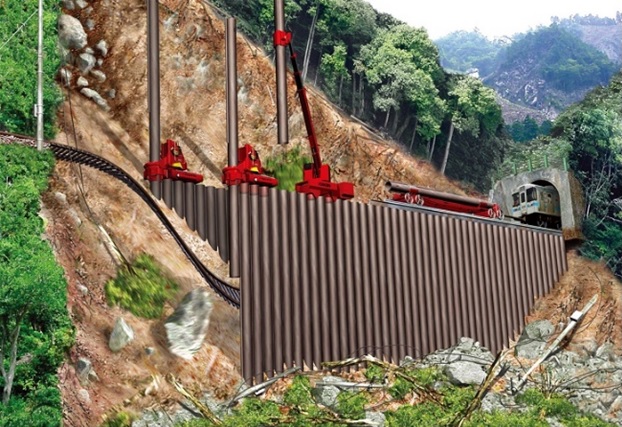The Philippines is exposed to a high risk of severe and frequent natural hazards due to its geographical location in Southeast Asia. Typhoons, heavy rains, earthquakes, floods, volcanic eruptions, landslides, and fires are among the natural hazards that affect the country. The Philippine government’s Mines and Geosciences Bureau (MGB) reports that the country ranks fourth among Indonesia, India, and China in terms of landslide risk, with up to 80% of its total land area susceptible to landslides. Today, Mayon Machinery (“MMRI”) is pleased to introduce a solution to minimize the damage by taking immediate action with implant restraining walls over all phases of landslide prevention from mitigation to recovery. The Implant Wall, constructed using the “Press-in Method” invented by Giken in 1975, acts as a restraining wall of the “Guard Method” or “Rescue Method”. These methods are designed to carry out protective work before and after the occurrence of unpredictable natural disasters.
Table of Contents
What’s Press-in Method?
The Press-in Method is one of the pile jacking methods that use a static jacking force to install piles into the ground. Its environmental impact of noise and vibration is smaller than those of conventional piling methods using drop hammers or vibratory hammers.
One of the characteristics of the Press-in Method that provides an essential difference from the other pile jacking methods is that a reaction force is secured from the previously installed piles.
Therefore, the space for piling and the cost of temporary works can be significantly reduced.
Exposition of the Solution “Implant Landslide Prevention Method”

The combination of the Implant Deterrence Piles and Implant Retaining Walls will prevent landslides caused by massive earthquakes and torrential downpours. Large preventive piles, with a maximum diameter of 2500mm, are embedded into the stable ground to hold soils and allow excessive groundwater to flow down through the pile gap. The Implant Retaining Walls act as a mass gravity structure providing stability to slopes against debris fall. Retaining walls can be over 9 meters high and support slopes by resisting lateral movement and pressure. They are pressed-in from the top of pile walls without disturbing daily life and the surrounding environment.
Methodology To Be Adopted in the Philippines
To build a strong continuous wall, called Implant Wall, in a hazardous location where there is a possibility and/or occurrence of landslides due to torrential rain, etc., the GRB system is used to significantly shorten the construction speed and reduce damage to people and property. It minimizes the working area to just the contact surface of the piles on the ground and eliminates the need for a temporary platform, even on slopes, uneven ground, and over water. If the situation changes after restoration, the wall can be removed for other purposes or moved to another location.
However, the GRB system is also used in auto to press-in a PC (Precast concrete) wall structure, etc., that is resistant to high temperatures, high-pressure steam, and volcanic gas, causing a pyroclastic flow down the mountainside when a volcanic eruption occurs.
What’s GRB system?
The “GRB™ System”, which allows all machines to self-move on top of the installed piles, enables construction work to be carried out even in disaster-affected areas, slopes, and narrow sites (Fig. 1). As the influenced area of work is limited to the width of the machines, the work can be carried out without disturbing the traffic flow around the construction site.

Although landslides usually occur without warning, it is important to understand this natural hazard and create a comprehensive landslide risk mitigation framework. Utilizing Giken’s Implant Landslide Prevention Method ensures the sustainability and expansion of landslide risk reduction. The method is proven to be so efficient and applied to over 36 countries worldwide. For more information on how to prevent damage from landslides to recovery after occur, please contact us today or enquire about sheet piling rental or sales throughout the Philippines.
